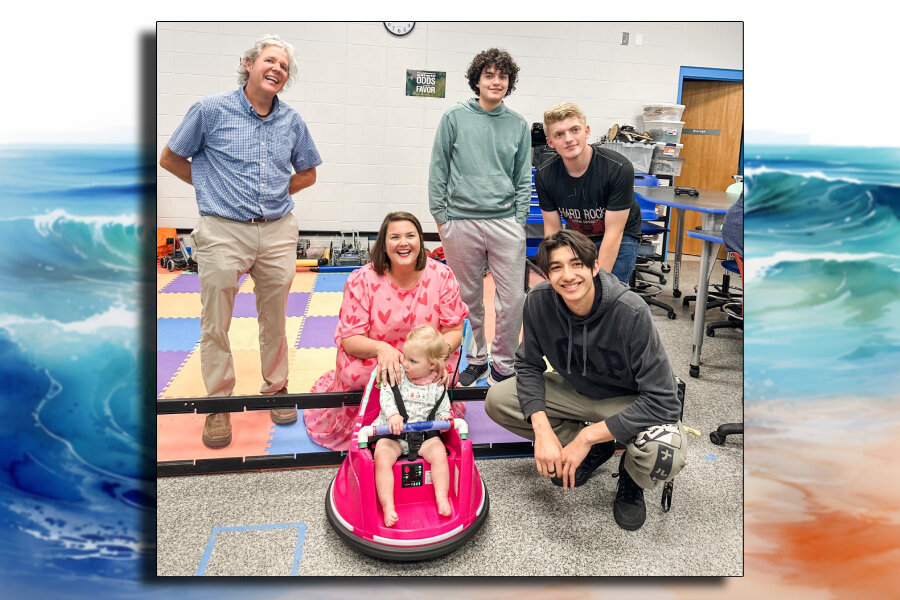In a heartwarming display of ingenuity and compassion, students at Gulf Shores High School's Center for Applied Design have undertaken a remarkable project to enhance the mobility of a child with a …
This item is available in full to subscribers.
Please log in to continue |

In a heartwarming display of ingenuity and compassion, students at Gulf Shores High School's Center for Applied Design have undertaken a remarkable project to enhance the mobility of a child with a rare condition.
"Witnessing the ripple effect of this project has been incredible," said James Salvant, Gulf Shores High School teacher and sponsor of the project. "It's not just about the amazing academic opportunities our students experience, but also the personal growth that is fostered through acts of service alongside the collaboration with our community, which is truly special. This has been one of the most rewarding projects of my career."
Crawford McWilliams initiated the project by reaching out to Salvant by email, seeking assistance for her daughter who suffers from CTNNB1 Syndrome.
CTNNB1 Syndrome is a rare genetic condition caused by mutations in the CTNNB1 gene, which plays a crucial role in various cellular processes, including cell growth and development. Individuals with CTNNB1 Syndrome often experience a range of neurological and developmental challenges.
CTNNB1 Syndrome is characterized by intellectual disability, ranging from mild to profound, and delays in motor skills development, including sitting, standing and walking. Speech and language delays, alongside behavioral challenges like autism spectrum disorder and hyperactivity, are common in those affected. Seizures are also prevalent among individuals with CTNNB1 Syndrome.
The symptoms and severity of CTNNB1 Syndrome can vary widely among individuals, making it a complex condition that requires tailored support and management approaches.
At 15 months old, Crawford's daughter, Shreve McWilliams, faces challenges in mobility, unable to walk or crawl. The proposed solution involved modifying an off-the-shelf kids' bumper car to provide Shreve with a means of mobility, offering an alternative to costly medical devices not covered by insurance.
Embracing the opportunity to make a meaningful impact, Salvant and his students, Lucas Pruett, Noah Tiffany, Ben Whatley and Jonnatan Batiz-Olivas, took on the project as part of the "Gulf Shores Give Back" program.
"... Making it was fun and educational, but seeing the joy that it brought to the little girl is what made it special to me," Pruett stated.
The students, armed with their creativity and technical skills, embarked on brainstorming sessions to devise multiple solutions tailored to Shreve's needs. Leveraging industry-standard software, they employed 3D modeling techniques to design various modifications for the bumper car. Using the prototyping equipment available in the Volkert Center for Applied Design, students successfully 3D printed custom controls, ensuring compatibility with Shreve's abilities. Additionally, they adorned the car with stickers featuring Shreve's favorite TV personality created by the center's graphics printer, adding a personalized touch to the vehicle.
Salvant and the students' creative efforts were eagerly anticipated as Shreve and her mother, Crawford, visited Gulf Shores High School to receive the modified car. The students' design, which allowed the car to move forward and backward while retaining the option to replace the original joysticks in the future, was praised. Shreve's delighted expression and enthusiastic response upon encountering the car highlighted the success of the project, as she maneuvered the vehicle with newfound independence.
For Salvant, the students and the McWilliams family, this project was a rewarding experience for all those involved. In a Facebook post, Crawford shared her gratitude for Salvant and the students who worked on the project: "My husband, Brenton (McWilliams), and I are so appreciative of their generosity and innovation to create a solution for our sweet Shreve. Thank you!"
To follow Shreve's story, follow the McWilliams family on Facebook at Shreve's Story - Finding a Cure for CTNNB1. To see more of what students and faculty are doing at Gulf Shores City Schools, visit www.gsboe.org.